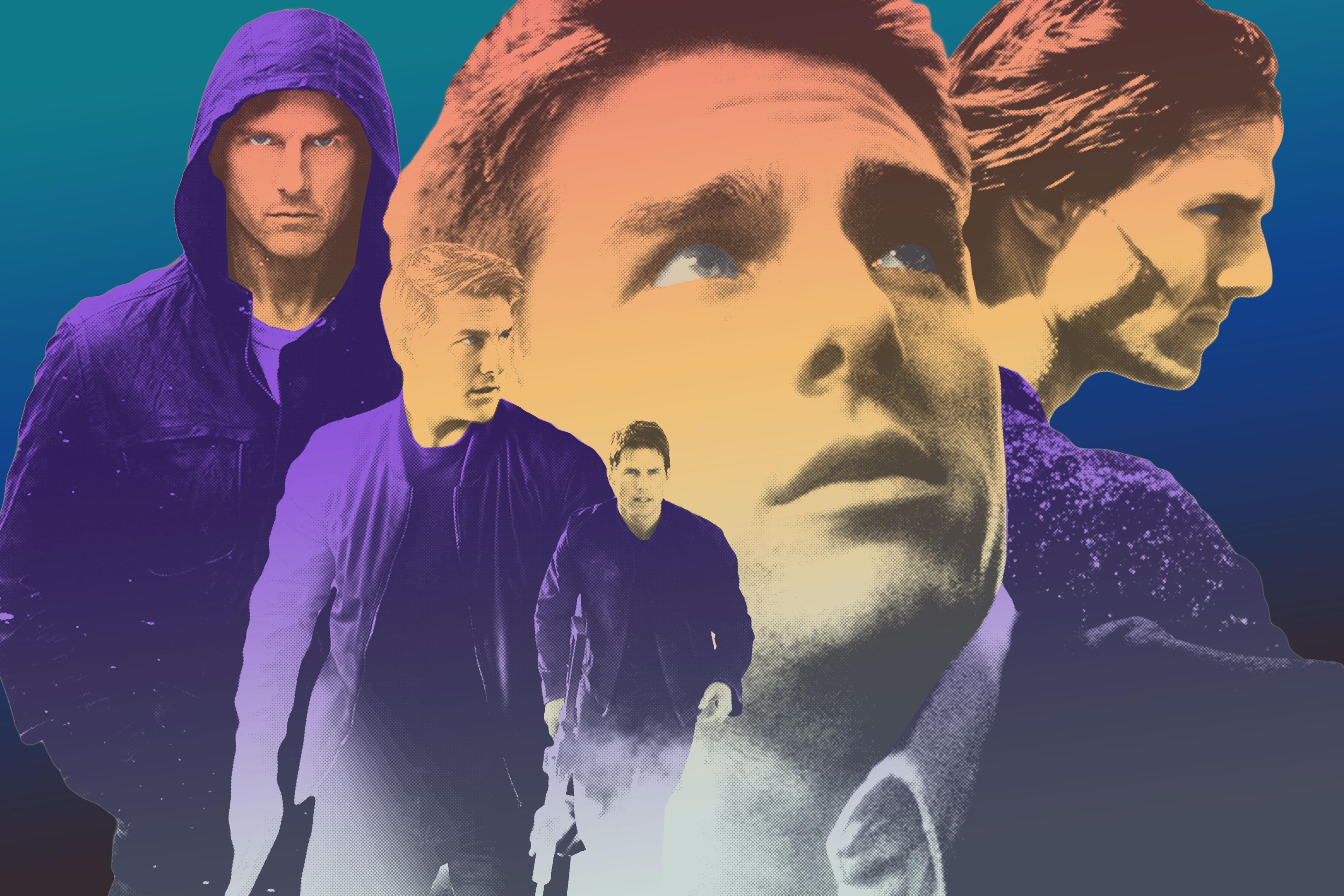‘Mission: Impossible’ Is the Best Movie Franchise—Here’s Why
And it keeps getting better. We ranked all six movies, with the lessons learned from each entry.Ranking franchise movies is the new stat-counting. It is both pointless and satisfying, calming and argument inducing. It creates order and frivolity in equal measure. In this time of expanding cinematic universes, rapidly adapted intellectual property, and the ever-gaping maw awaiting time-killing content, we rank. We rank, therefore we are.
Fortunately, the Mission: Impossible movies are worthy of the form, because each entry indicates a shift or improvement in moviemaking strategy and franchise storytelling. It codified—and then broke—the “One Director’s Vision” concept that has become so prevalent in the Marvel canon. It’s a long-running but not urgent property; when a new one arrives, it’s less a consequential continuation of mythology than it is a fun diversion. The stunts are real and the stakes are massive, but the end game is modest: Just wow us.
In 1996, when Tom Cruise sought to launch Mission with his producing partner, Paula Wagner, studios were reluctant to invest in an expired TV property, thinking it beneath the mega-wattage of Cruise. Twenty-two years later, it’s entered the firmament of summer studio staples. And they’re coming more frequently now. Five years passed between the third and fourth installments; four between the fourth and fifth; and now just three between the fifth, Rogue Nation, and this week’s Fallout. The last two were written and directed by the Academy Award–winning screenwriter Christopher McQuarrie (The Usual Suspects, Edge of Tomorrow), who has brought a new energy to the series, at once emotional and breakneck. Fallout is perhaps the most purely entertaining yet.
Among American franchises, Mission: Impossible ranks just 26th at the box office. But, as long as Cruise can withstand the physical consequences of leaping off of buildings, swimming through Tauruses, crashing helicopters, and running really, really fast, it will likely continue to grow without necessarily “expanding.” It’s a series that knows what it is, and we do, too. Herein are six lessons from the six movies about how to evolve, adapt, and protect a franchise.
6. Mission: Impossible II (2000)
Directed by John Woo
The Lesson: Catch a Director at the Right Moment
This is the only Mission: Impossible film that doesn’t completely work, and it’s mostly a consequence of styles clashing. By 2000, the iconic Hong Kong action director John Woo had successfully translated the operatic, rampaging vision of crime dramas that he developed with A Better Tomorrow, The Killer, and Hard Boiled to the United States. His early American work was ludicrous, but deeply fun and true to his aesthetic, specifically the timelessly preposterous Face/Off. But that absurdity is nowhere to be found in M:I II, which plays more like a martial arts revenge saga than a slick spy movie, a gritty underworld tale, or the winking self-referential tone it has adopted in recent years. Unfortunately, Woo, who was 54 when II was released, was on the back nine of his career. He never made a movie as big or as relevant, and his approach just wasn’t a fit. Every filmmaker in the series who has followed has had something to prove to audiences. Woo—like his predecessor Brian De Palma—was already a legend. But something had gone missing.
5. Mission: Impossible — Ghost Protocol (2011)
Directed by Brad Bird
The Lesson: Don’t Try to Replace Ethan Hunt
Remember when Jeremy Renner was going to take over this franchise for Tom Cruise? That feels ridiculous and like quite some time ago now. Ethan Hunt—dogged, singularly focused, defiant, always reeled into some mess he wants no part of—is the centerpiece of the story and needs to be. Mostly because of Cruise and his character’s mad-eyed, weirdly sentimental connection to a government organization that keeps putting him in situations that want to kill him. He isn’t a patriot so much as a masochist.
Audiences may not be as enraptured by Cruise’s effortless charisma as they were in the ’90s. A fraught and complicated series of events in his personal life made him a difficult figure to root for. But Mission: Impossible never wavered. It appeared, regularly, a constant despite the tumult. When Brad Bird came on to direct this fourth edition, he rejuvenated the movie at the box office (it’s the second highest-grossing) and put a little verve in the machine. But there’s a fly in the ointment. Renner’s William Brandt, a sighing cipher, was rumored—but never confirmed—to be an eventual replacement for Cruise. Ultimately, Brandt—well-trained but affectless—never stood a chance. His character is a bureaucrat with fists. Ethan Hunt is a lifestyle.
4. Mission: Impossible — Rogue Nation (2015)
Directed by Christopher McQuarrie
The Lesson: Expand the Universe
When McQuarrie took the reins, the franchise was in an unusual place. He’d done an uncredited rewrite on the previous film and sensed that the series needed some new emotional stakes. Ghost Protocol was huge, but oddly inert upon a rewatch. The Burj Khalifa stunt was unforgettable—the rest of the plot is hard to remember. So McQuarrie shifted gears. The introduction of Ilsa Faust (Rebecca Ferguson) throws Hunt for a loop, puts Brandt on the backburner, and reintroduces a little romantic tension into his life. The sexless, mission-driven aspect of Bird’s movie made Hunt seem monklike. But that isn’t the guy who stared down Max and wooed Claire with magic in the first film, and it isn’t the guy who swooned over Jules in the third. Fittingly, Ilsa—thanks to McQuarrie—brought with her a worldwide anarchist collective called the Syndicate (sure, why not) that would define the series going forward, putting stakes in the stakes. And she brought Hunt back to a human level.
3. Mission: Impossible III (2006)
Directed by J.J. Abrams
The Lesson: Make the Villain Mean. Really Mean. Evil.
Owen Davian is one of Philip Seymour Hoffman’s best roles. It isn’t nuanced like Capote, heartbreaking like Scotty J, manic like Gust Avrakotos, or mysterious like Lancaster Dodd. It’s just evil, a vicious distillation of pure and unrelenting capitalist meanness. Davian is the arms dealer at the center of J.J. Abrams’s stab at the franchise, and he is casually, calmly vicious.
During this scene, Hoffman talks plainly, like a vindictive monster with no conscience. “You have a wife … girlfriend? Because you know what I’m gonna do next? I’m gonna find her, whoever she is. I’m gonna find her and I’m gonna hurt her. I’m gonna make her bleed, and cry, and call out your name. And you’re not gonna be able to do shit. You know why? Because you’re gonna be this close to dead. And then I’m gonna kill you right in front of her.”
It’s still bracing to watch Hoffman work in this movie. It’s an especially unconventional choice in a series that often relies on silly MacGuffins, ridiculous heists, and literal masks to keep an audience at attention. After utilizing magic tricks to set the stage through two movies, Abrams and Hoffman trade sleight of hand for blunt force trauma.
2. Mission: Impossible — Fallout (2018)
Directed by Christopher McQuarrie
The Lesson: Don’t Forget Continuity
One of the best things about Fallout is what makes it so different from what came before … and so similar to other franchises: It fits together. In this new movie, the Syndicate is back. Sean Harris’s Solomon Lane is back. Ilsa is back. Luther and Benji are back. Alec Baldwin’s slippery G-man Hunley is back. This is a movie that fits together with Rogue Nation—it’s more rewarding when they’re seen in succession. What makes the Mission movies fun is right there in the title—they’re individuated, stand-alone stories with an extraordinary goal at the heart. But that doesn’t mean there can’t be a repertory company and a continuing arc. More than Tom Cruise’s fearless stunts or McQuarrie’s rat-a-tat repartee, it’s that connectivity that makes Fallout feel so vital. This is a movie in a world we know, and never want to leave.
1. Mission: Impossible (1996)
Directed by Brian De Palma
The Lesson: Franchise Isn’t a Dirty Word
While Brian De Palma watched his pals George Lucas, Steven Spielberg, and Francis Ford Coppola build franchise empires and scale the movie business to the height of their imagination, the Movie Brats’ fourth compadre worked in a cocoon. His films in the ’70s and ’80s were brash, often violent, sexualized thrillers indebted to Alfred Hitchcock. They were elegantly composed and bracing works that sometimes struggled to exceed their own commitment to the ecstatic. But decades after Star Wars, Indiana Jones, and The Godfather, De Palma finally took a studio gig with Mission: Impossible and became a part of a template that is being copied to this day. It’s his movie, through and through. And it vanishes from his hands the minute it ends. In the Mission: Impossible parlance, he accepted the mission, and then it self-destructed.


